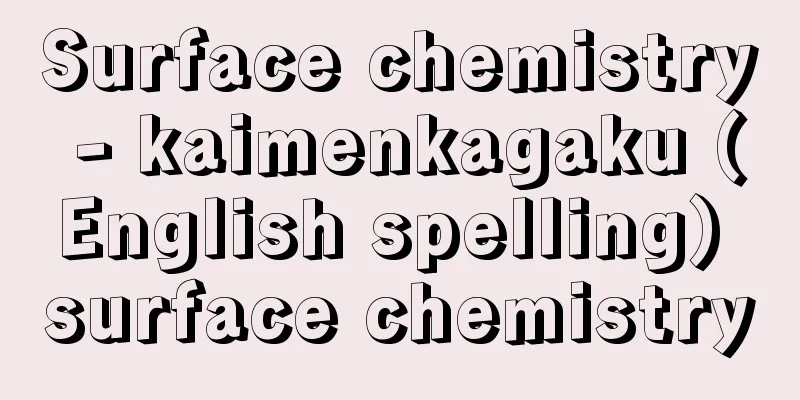Surface chemistry - kaimenkagaku (English spelling) surface chemistry

|
A branch of chemistry that systems up the phenomena that occur at interfaces from a physical-chemical perspective. An interface is a boundary surface that is formed when two phases with different properties come into contact. For example, the interface between air and marble, or the interface between water and oil, are both interfaces. When focusing on the state of the phases that make up the interface, there are five types of interfaces: (1) gas and liquid, (2) gas and solid, (3) liquid and liquid, (4) liquid and solid, and (5) solid and solid. Here, when one of the phases that make up the interface is a gas, as in (1) and (2), it is called a surface. The interface itself has a tendency to reduce its area, and when this tendency is large, the surface (or interfacial) tension is said to be large, and when it is small, the surface (or interfacial) tension is said to be small. [Shigeo Hayano] Adsorption and surface activityThe phenomenon in which a substance that exists at a uniform concentration inside a gas or liquid gathers in greater amounts at the interface is called adsorption. Adsorption can occur for both chemical and physical reasons. When a surfactant is dissolved in water, it dissolves to some extent in the water, but adsorbs in greater amounts to the surface of the water, greatly reducing the surface tension of the water. This property is called strong interfacial activity. In a broad sense, interface chemistry is the study of interfaces, including catalytic chemistry, which deals with the properties and functions of catalysts, electronics, which deals with the flow of electrons in semiconductors, which are important elements of electronic circuits, and electrochemistry, which deals with the flow of electrons across the interface between an electrode and a solution in batteries, which convert solar energy and chemical energy into electrical energy. In recent years, there has been a dramatic advance in technology for measuring solid surfaces, and the importance of interface chemistry is gradually increasing. [Shigeo Hayano] [References] | | |Source: Shogakukan Encyclopedia Nipponica About Encyclopedia Nipponica Information | Legend |
|
界面で生じる現象を物理化学的に体系づけた化学の一分野。界面とは性質の異なる二つの相が相接したときにできる境界面である。たとえば空気と大理石との境界面、あるいは水と油の境界面はいずれも界面である。界面を構成する相の状態に着目すると、界面は次の5種類となる。(1)気体と液体、(2)気体と固体、(3)液体と液体、(4)液体と固体、(5)固体と固体。 ここで(1)と(2)のように界面を構成する相の一つが気体の場合には、それを表面とよぶ。界面はそれ自身その面積を小さくしようとする傾向があり、この傾向が大きいときには表面(または界面)張力が大きく、小さいときには表面(または界面)張力が小さいという。 [早野茂夫] 吸着と界面活性気体または液体の内部で一様な濃度で存在している物質が、界面により多く集まる現象を吸着という。吸着は化学的な原因からも、物理的な原因からもおきる。界面活性剤を水に溶かすと、水中にある程度溶けるが、水の表面により多く吸着し、水の表面張力を大幅に低下させる。このような性質を界面活性が強いという。 触媒の性質や機能を取り扱う触媒化学や、電子回路の素子として重要な、半導体の中の電子の流れを取り扱うエレクトロニクス、あるいは太陽エネルギーや化学エネルギーを、電気エネルギーに変換させるものである電池に関して、電極と溶液の界面を横切る電子の流れを取り扱う電気化学も、広い意味では界面に関する学問である。近年、固体表面を測定する技術が飛躍的に進歩し、界面化学の比重がしだいに大きくなっている。 [早野茂夫] [参照項目] | | |出典 小学館 日本大百科全書(ニッポニカ)日本大百科全書(ニッポニカ)について 情報 | 凡例 |
<<: Surfactant - Surface active agent
Recommend
Durum wheat
A type of wheat with 28 chromosomes, the same as e...
Ājīvika religion - Ājīvika religion (English spelling)
The religion to which Gosala, one of the six India...
Giten
A monk from Goryeo (Korea). His posthumous name w...
Supply - supply
〘noun〙① To give something. To offer. Gukyu. In the...
The Great Dictionary of Government Policy (English: Kyǒngguk-daejǒn)
Code of Laws of the Yi Dynasty, Korea. 6 volumes. ...
İznik (English spelling)
A town in northwestern Turkey. Originating from th...
Excavation of Okagata Shinko irrigation canal - Okagata Shinko irrigation canal excavation
...Because the domain contained vast areas of low...
Udakopasparshana - Udakopasparshana
…Ritual baths have been discovered in the ruins o...
Automobile insurance - jidoushahoken
Insurance intended to compensate for bodily injur...
Large broom moss - Large broom moss
...The perianth has a narrow opening and is bud-l...
Hokitika - Hokitika (English spelling)
A city in the mid-west of New Zealand's South...
Danaid eggfly
This butterfly belongs to the family Nymphalidae,...
Passerine
...In Europe and India, the closely related house...
Convolvulin
…The dried tuberous root is called jalapenoide, w...
Horned stink bug (horned stink bug) - acanthosomatid bug
A general term for insects of the Hemiptera family...









